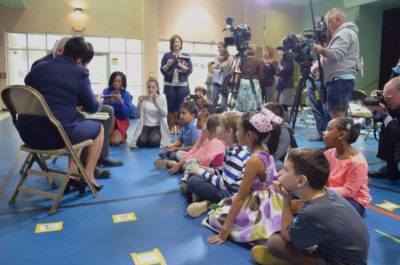

Speaking in the East Room of the White House, President Trump asserted that “the press has become so dishonest” — and that its “level of dishonesty is out of control.” He followed up the next day with a tweet that, after mentioning several national news organizations, broadly declared the news media “the enemy of the American people.”
You may have seen and heard the president holding forth at that combative news conference last Thursday because national TV networks carried it live, and national news organizations quoted him accurately in print and online. Even if you are not among the president’s Twitter followers, you may read the text of his scornful “enemy of the people’’ tweet because national news organizations posted it on their websites.
From their own media consumption and conversation among peers and at home, surely many of our middle- and high-school students have some awareness of the roiling national debate over “fake news,” “alternative facts,” and a new president who quite regularly makes, and sometimes repeats, statements easily found to be false. Shortly after the November election, I wrote that the 2016 campaign should serve to stimulate a reinvigoration of the teaching of democratic and civic life in our schools. Now I would add “news literacy’’ as a key component of civic education.
In our polarized times, I am aware, some public school teachers and principals would be skittish, even to the point of fear for their jobs, to venture into classroom discussions that might be interpreted as too political or too tilted to one side or another. Indeed, Trump has shown disregard for laws, rules, and norms that even down-the-middle teaching of civics and news consumption would come across as biased against the new president.
And yet, our nation’s long educational project has had at its core a belief that more knowledge makes better citizens who make democracy, the economy, and communities better. For schools to shy away from teaching about democracy and news in American life would amount to an abandoning of a foundational role.
Let me suggest a few basic concepts and observations to inform the interaction between teachers and teenagers as they come of age as citizens and news consumers:
- Professional, independent journalism is essential to an effective and ethical democratic and capitalist society. A back-and-forth flow of reliable information and deliberation, including often-heated debate, keeps people connected to their local community and to their nation. It’s the job of journalists to quote the president accurately even when he says something demonstrably false, and it’s also the job of journalists to follow up by reporting facts. Citizens need information to cast an informed vote and to hold people in power, whether in government or corporations, accountable. No free press, no free people.
- Media are plural. Yes, the United States has a few powerful East Coast-based national news organizations, but American media consist of a wide array of publications and broadcast entities. Fox News is not the same as The New York Times, which is not the same as the Wall Street Journal, which is not The Atlantic, which is not Women’s Wear Daily, which is not Sports Illustrated. While recent polls indicate relatively low public approval of the “mainstream media,’’ the reality is that Americans have multiple choices of media through which to inform themselves.
- Media make mistakes, just as corporate executives, legislators, presidents, and all human beings do. Often the media deal too much in the trite and trivial. Still a mark of responsible journalism is a readiness to correct mistakes and to remain transparent to readers about who is in charge and open to criticism. And yes, the news often comes wrapped in opinion or perspective — and yet, readers and viewers can assess the credibility of opinion journalism by its fidelity to the values of verification of facts and of pursuit of truth. Teachers can help students form the habit of reading or watching two or more credible sources of professional journalism.
- Around the globe, media continue to struggle in an era of disruption. The internet has set loose a torrent of websites, blogs, tweets, TV talk. Outside of New York City and Washington, DC, metropolitan newspapers have downsized; new news organizations (including EdNC) have arisen here and there to fill the gaps. My university students hardly open a newspaper these days; they, their peers, and young students get news through Google, Facebook, and such, and through them credible, non-credible, and incredible reports look the same. Teachers can help students negotiate their way through the new media landscape, which practically requires Americans, young and old, to become more savvy news consumers.
Footnote: At the recent North Carolina Scholastic Media Association Advisers meeting, Stephanie Willen Brown, director of the UNC Park Library, gave a presentation that pulled together educational material for high school teachers to consult for media and news literacy instruction. The Park Library is housed in the UNC School of Media and Journalism, as is the Scholastic Media Association, whose director is Monica Hill. Here are links to the chief sources for that presentation:
- Brown, Stephanie W. “Checking Facts.” UNC School of Media & Journalism, Feb. 10, 2017. http://guides.lib.unc.edu/mejo153/checkingFacts
- Green, Matthew. “The Honest Truth about Fake News … and How Not to Fall for It (with Lesson Plan).” The Lowdown, KQED News, Dec. 6, 2016, https://ww2.kqed.org/lowdown/2016/12/06/the-honest-truth-about-fake-news-with-lesson-plan/ .
- Stony Brook University. “News Literacy (JRN101) Syllabus.” Spring 2017, http://drc.centerfornewsliteracy.org/course-pack
- Wineburg, Sam et al. “Evaluating Information: The Cornerstone of Civic Online Reasoning.” Stanford History Education Group, Nov. 22, 2016, http://purl.stanford.edu/fv751yt5934 .


